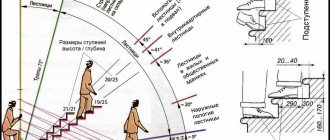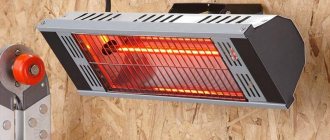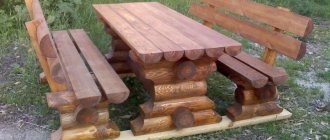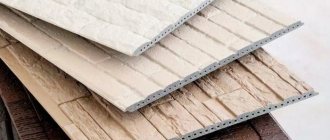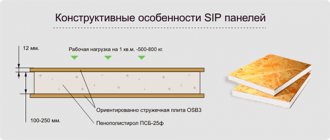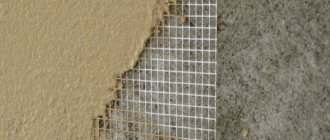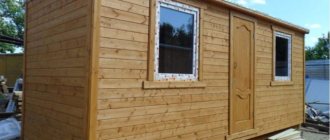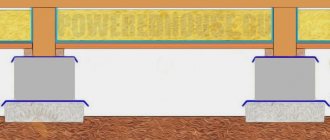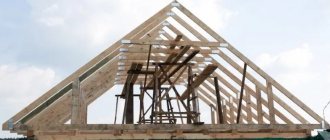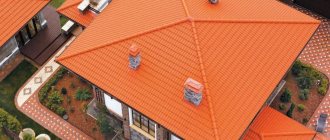Video: Adhesive method of fixing carpet.
There are times when you purchase a house with a finished staircase and you are not satisfied with its appearance, or when changing the interior, the color of the staircase design no longer suits you; rugs for the stairs or carpeting the steps will help solve this problem. Stores offer a huge selection of carpets in terms of quality and color palette. What kind of carpet should we choose for the stairs so that it lasts a long time and suits its characteristics? Let’s take a closer look at this issue.
This method of fixation can be used at temperatures from -20 to +50 degrees. Excellent for all types of surfaces, including those with uneven surfaces.
Double-sided adhesive tape
Fastening the carpet on the stairs is possible using a special adhesive tape coated with an adhesive substance on both sides. Typically, the base is a strip of fabric (mostly cotton), on both sides of which rubber-based adhesive is applied.
The great advantage of using this material is its ease of use.
Installation can be done independently, but all operations should be carried out in stages:
- the required coverage is selected;
- the carpet is leveled (during the day it is in an unbent position);
- tape is applied to the surface (first along the perimeter, then in the form of a grid with cell sizes of 50x50 cm, or based on the design parameters);
- The track is laid, after which it is pressed at the points of contact with the adhesive tape.
This method of fixation can be used at temperatures from -20 to +50 degrees. Excellent for all types of surfaces, including those with uneven surfaces.
Some coating options already include double-sided adhesive tape. This makes the fastening process easier.
Rugs with self-adhesive elements provided:
Attaching the mat to the stairs
Reliable installation of carpets on stairs is possible with the help of fixing slats. This is a rather labor-intensive process that requires the use of additional materials, but it guarantees reliable fixation. The work is carried out in several stages:
- along the back of the tread, a strip with spikes is laid (driven in with nails pointing upward); for greater reliability, the strip can be positioned in the form of a corner between the tread and the riser;
- before laying the carpet, the stairs are covered with a felt layer;
- the track is pulled with maximum force over the felt;
- the carpet is pulled into the gap formed between the slats using a chisel;
- in the places of the slats, you need to tap with a chisel or gentle blows of a mallet (this will ensure reliable fixation);
- at the point of contact with the wall, trimming is carried out along the bend line;
- at the end, the material is fixed with two rows of spikes, which are covered with a metal strip.
Using this option is less gentle than the previous two, but guarantees reliable fixation.
Each of the presented options has its own disadvantages and advantages, and their use must be chosen based on a number of features:
- staircase design features;
- degree of load on the surface and stairs (intensity of pedestrian traffic, carried loads);
- temperature conditions;
- design ideas;
- the prospect of using uncoated stairs (in the future);
- the ability and desire to carry out work independently (or with the help of employees with the necessary experience).
By correctly selecting all the necessary parameters, you can achieve maximum fastening efficiency. Using each of the presented options allows you to maintain a fairly good appearance of the staircase, which will allow it to look beautiful even if the carpet is removed.
You can fix the carpet on the stairs using these methods without having any special construction skills. It is enough to familiarize yourself with the procedure for carrying out the work, select the required tools and you can begin to carry out the work.
Video: securing carpet using a holder:
Other articles
- The height of the railing (fence) on the stairs according to GOST in Belarus
- Hot forging
When arranging the interior space of the house, you should take care of the safety of movement on stairs, especially if children or elderly relatives will live here.
PREPARATION AND PAINTING OF STAIRS
Step 1: Fill all cracks and holes with putty. Before this, you can sand the steps, which will help you see all the irregularities. In our case, the stairs were simply vacuumed, since the largest holes from nails and staples were 10 cm from the walls on each tread and on each riser.
When working with putty, it is recommended to use a spatula.
In areas where there is significant damage to the wood - large cracks and chips - a spatula is especially useful.
However, you can use your own fingers to seal small cracks and holes, in which case this method is much more effective. Allow the putty to dry thoroughly (recommended time is at least 2 hours).
Step 2: Sand the dry putty areas with sandpaper. Use a medium-grit sandpaper, such as 8-N, and sand the surface of the steps so that it is perfectly smooth - both treads and risers. If necessary, repeat the putty step until the entire surface of the steps is even and smooth (in this case, two full tubes of putty were used).
Step 3: Sealant treatment. Once you're finally done sanding and smoothing the surface of the steps (which may take a day or two), you may find that the edges of the steps where they meet the wall need sealant.
If you are installing new carpet, it is not necessary to seal the central areas between the tread and riser.
Apply caulk to areas along the edges of the risers, treads and noses, and also a little at the junction between the riser and tread.
This is what a fully prepared staircase looks like, treated with putty, sanded (in several stages) and treated with sealant. Once the sealant has dried, the staircase is ready to be primed and painted.
Painting Step 1: Apply primer to the steps. Here, an angled brush was used to treat the sealed joints and the wooden surface of the steps. Do not skimp on the primer - treat the entire surface on the sides of the steps with it, even if it is hidden under the carpet.
The primer dries fairly quickly - most likely, by the time you finish finishing the edges, the staircase will be ready to paint. If you wish, you can sand the surface of the stairs a little more at this stage.
Painting, step 2: Apply paint:
Stir the paint thoroughly (if you prefer to tape off certain areas of the steps and leave them unpainted, now is the time to do this).
Apply the paint to the areas you have marked (in this case, areas approximately 10 cm wide on the sides of the steps) using light brush strokes, making sure that the painted surface is even.
Let the paint dry. Lightly sand the painted surface with sandpaper where you feel it is needed, and then apply one or more coats of paint, depending on your preference. In this case, the paint was applied in three layers.
How to correctly calculate the amount of carpet
Starting at the very top, determine the length of all risers and treads using a tape measure, add 4 cm to the size of each step, then add up all the numbers.
If you are going to sheath a turning staircase, use the outside edge to measure. To determine the width, measure the widest step at the turn.
For an open staircase, add an additional 4 cm to the width of the steps to roll up the covering.
IMPORTANT: The flight of stairs must be covered with carpet from the top landing to the bottom riser.
What tools and additional materials will be needed for the work:
- On glue.
- On duct tape.
- With carpet holders.
- On wooden planks
Glue option
Stages of work:
You should carefully calculate the footage of the track. Take into account not only the length of the span, but also the width and height of the steps.
In museums and representative institutions, there are metal rods on the stairs that were installed more than 50 years ago. They are luxurious and comfortable. And even a novice master can master such an installation on wooden steps. For staircase openings made of other materials, it is better to invite an experienced person.
Carpet runners for stairs are laid without cutting the material into each individual element. This option is applicable for straight staircase structures, preferably without a tread protrusion above the riser.
Finishing stairs with carpet, depending on the required result, is divided into three installation options:
On adhesive tape
The path is spread on the floor and left to level for two days. Prepare 2-3 rolls of double-sided adhesive tape (adhesive tape) and scissors.
The covering is placed inside out. Place tape around the perimeter of the product. It is recommended to keep the tape in the refrigerator for a while before work. Easier to unwind.
Then place the tape lengthwise and crosswise to form squares of 40-50 cm. Do not immediately remove the top layer so that the carpet does not stick together when moving on the steps.
The path is laid and leveled. Starting from the top, the top layer of tape is gradually removed and the mat is pressed against the stairs.
When using this technique, the steps are allowed to have unevenness and errors.
Take measurements from the largest step and multiply the resulting value by their total number. Such a calculation already includes allowances for waste that may be generated when cutting carpet.
Materials
Many owners of suburban areas are interested in the question of what to use as paths or overlays on the staircase structure and what should this material be?
There are a number of requirements for such a coating:
- High-quality carpet material for paths must have a special marking, namely “for stairs.” After all, the covering for steps must be strong and durable. To do this, it has a special base and a special pile coating that is wear-resistant;
- If it was decided to fix the covering on the steps without preliminary gluing, then experts recommend purchasing carpet material with a rubberized base;
- If the house has a concrete staircase, then the carpet on its steps must be carefully fixed using holders. Then it will not slide off when using the structure. In other words, a design with such steps will be really safe and also very attractive;
Practice shows that the most popular options for overlays for stairs in the house are:
- corridor carpets;
- carpet pads in the shape of a semicircle, quadrangle or triangle;
- floor carpets.
A beautiful carpet on stair steps is the key to their safety and the comfort of the home owners. It is also worth noting the fact that a similar design of a lifting mechanism in a private residential building can be completed quite quickly. And the fact that carpet overlays on the steps of the stairs look incredibly interesting cannot be understood only by a blind person.
Perhaps you prefer to see a rug on your stairs without patterns or with a more subtle design. In this case, ordering a carpet from a specialist is an excellent solution. This coating will be adjusted to the dimensions of your stairs.
Sometimes ordering a path is significantly cheaper than purchasing a ready-made covering. You can save money by purchasing carpet cuttings for making at a discount - specialists will simply adjust it to the shape and size of your stairs.
Carpet calculation
- Measurement starts from the top, and all treads and risers are summed up. It is recommended to add 4 cm to each step.
- Screws are measured along the outer edge. The width of the covering should correspond to the widest step at the turn.
- If the stairs are open on one side, add another 4 cm to the width of the covering at its hem.
To calculate the material, use the following method, which works even in the most difficult cases.
Take measurements from the largest step and multiply the resulting value by their total number. Such a calculation already includes allowances for waste that may be generated when cutting carpet.
Laying methods
Solid steps look much more beautiful, however, they are more difficult to lay.
The cutting of product elements is carried out for each step separately. The work is greatly simplified by using templates. It is cut out along the fold lines from thick paper. In this case, the cutting will be more accurate and the need for adjustment will be reduced.
The flooring is laid by smoothly connecting the elements to each other. The most convenient joining of carpet is on adhesive canvas. This method allows you to quickly replace the old coating with a new one. You can connect one part to another using glue or fixing strips that have jagged edges.
Technology for laying carpet on stairs using fixing strips
If necessary, the steps are pre-repaired and painted. Then, in the corners between the risers and treads, strips are nailed to fix the covering, directing the nails towards the corners. This can be a special L-shaped clamp or two ordinary strips, each of which should be 12 mm from the corner.
The planks for the platform are cut to length with a special hacksaw - a reward and fixed in the same way as laying the covering indoors. Before proceeding directly to laying the carpet, the fixing strips for the stairs must be completely installed.
The backing is cut out according to the width of the carpet and the length of the narrow section with an allowance for the length of 25 mm. The material is placed on the upper tread, and it should fall through the roller. Then they secure it on three sides, the back and side edges, with nails or staples. Do the same with all treads.
The carpet from the upper platform is cut with a carpet knife. The top of the riser should remain covered. Place the material on the fixing bar and cut off the excess.
Align the edges of the material on the bottom step and the top tread, then place its end on the teeth of the clamp and secure it using a scarpel and a mallet. This process looks like this in more detail: starting from one corner, using a scarpel, the material is placed on the teeth of the strip, gradually moving in the opposite direction. For better fixation, tap the scarpel with a rubber mallet. During the fastening process, the canvas is unrolled at the next stage.
The carpet must be leveled at each step. If necessary, the roll is moved. When completing the span, excess covering is cut off. Excess pieces are also cut off on the upper step.
Overlays for steps
There is a trick that will help the flooring wear out more evenly: at the top step, wrap about a meter of material underneath, and after a year, release the tension from the raw material and move it slightly, having first unrolled it.
REMOVAL OF OLD CARPET
Step 1: Let's begin removing the old carpet. Firmly grasp the corner of the carpet and pull towards you, separating it from the step. Continue until the first top step is completely clear of the cover. We advise you not to rush and work on each part of the staircase separately - that is, move to the next section only after you have cleared the previous one.
Tip: Wear gloves and be extremely careful. The metal staples that secure carpeting to stairs can be subtle and treacherous.
Use a flathead screwdriver to release all visible staples in the riser
Work carefully so as not to damage the wood, especially if you are simply painting the steps without laying a path
Remove the staples from the wood using pliers. When you think you have removed all the staples, gently run your (gloved) hand over the wood surface before moving on to a new area. There is a possibility that you will find a couple more staples hidden from view. Remove them too.
Step 2: Remove the grip strips and undercarpet pad from the tread. Gripper strips are typically narrow strips of wood with small nails that secure the edges of carpet to the floor and keep it stationary.
Taking into account nails, they should be removed carefully using a hammer and a nail puller
Tip: If the undercarpet pad is in good condition, you can leave it (or some of it) on the treads as a cushion between the steps and the carpet. In this case, only the edges of the gasket were removed, the rest remained in place.
Here's what the treads and risers should look like after the carpet is removed: all staples removed, padding trimmed, and grip rails removed.
Step 3: Continue in this manner until you have cleared the entire ladder. In our case, the work was carried out gradually: first, the carpet was removed from two or three steps, then cut off with a knife.
Advice: for your own safety, it is better to leave the covering on the lower steps where you sit while working on the upper ones.
Here's what the whole staircase looked like after most of the work on the straight steps was done. There is nothing difficult in removing the coating from wedge-shaped steps (note: a staircase with a turn like the one in this photo is called a spiral one).
Rules for laying carpet on different types of stairs
First, before starting the process of laying the coating on the reconnecting structure, we will provide basic general recommendations.
Note that when moving along a staircase, regardless of the direction, the load on the tread rollers acts in the downward direction, therefore, in order to reduce the deforming loads on the base of the flooring, the sheathing should be laid with fibers in the downward direction. The direction of the pile can be determined in a completely simple way: a lightweight hammer with a small handle, which is directed upward, falls from a short distance from the surface in the direction of the pile.
To estimate the required area of the required material, we start by measuring the width of the span. Since the width of the treads is most often not constant, it is worth measuring each one separately. With an open type of installation, we will add about 6 cm to the width for the purpose of later bending the edges of the fabric. Next, we measure the length of the ascending fold: from the top step to the bottom we lay the thread, observing the installation profile, and add 0.25 cm per unit step to take into account the thickness of the lining.
When purchasing cladding with a pattern, you need to make provisions for combining the pattern with the middle of the tread and with the pattern of the lining on the landing or in the hallway.
The number of linear meters of wide flooring is determined as follows: divide the length of the installation by the number of panels into which a standard carpet can be cut, taking into account the width of the roll. However, this is an approximation, since the joints should always be located in the corners between the treads and risers: the top end is laid at the rear edge of the step, and the bottom is cut at the bottom edge of the riser. In any case, for each type of coating, the calculation method is used exclusively.
Installation methods for laying can be somewhat different, depending largely on the design of the ascending structure itself and on the shape of the treads. It is simply impossible to cover an ascent with winder steps with a continuous covering from top to bottom. For this method, buildings with rectangular cross-section steps are suitable. Under other conditions, it will be necessary to cover the structure with separate patterns.
There is a trick that will help the flooring wear out more evenly: at the top step, wrap about a meter of material underneath, and after a year, release the tension from the raw material and move it slightly, having first unrolled it.
Covering a spiral staircase from the very top to the bottom landing, as well as from one end to the second edge, is somewhat more difficult, because you need to work with each tread separately. The clamping slats are adjusted using the same method as for right ascension, after which the slats are nailed to the ends of each step. When laying the material from top to bottom, separate pieces are cut off in turn for each fault, but do not forget to take into account the location of the pile; it is advisable to maintain one direction.
Immediately before installation, the stairs must be re-cleaned of dust and debris.
About fastening methods
What kind of carpeting is there - artificial grass examples
So how do you secure the supports to the stairs? There are three main methods:
- using dowels;
- on self-tapping screws;
- using pins.
Sometimes balusters are fixed to the steps and floor directly, and in the upper part - with the help of a sub-baluster strip. But this element is not required.
Wooden balusters can be fastened with studs
Wooden balusters are usually attached using threaded fasteners. Some columns are poured directly into concrete if the stairs are made of it. But impact dowels can also be used to secure supports to concrete. Also, to increase the reliability of connections, assembly adhesive is used when assembling the structure.
How dowels are used
This is one of the simplest options for attaching balusters. Dowels are small-sized wooden plugs or choppers; they simply need to be inserted into grooves prepared in advance, which are cut out both in the stairs themselves and in the balusters in their lower part. In another way, this connection method can be called “tongue and groove”.
Wooden dowels
This method is used only for attaching wooden supports - it will not work for other materials. In the case of a bowstring, holes are created in the latter at equal distances, the diameter of which will be equal to the diameter of the dowels. The same holes are drilled at the base of each support. The dimensions of the grooves should be such that the dowel fits tightly into them.
Installation of balusters to the stairs using dowels
One of the balusters will also have the function of supporting the railing, so it should be secured not to a dowel, but to an anchor, and attached directly to the floor
In this case, it is important to follow a simple rule - the inner wedge is not twisted, but driven with a hammer to the limiting edge. The installation of a bowstring or railing is usually done after all the supports have been attached.
Wooden dowel plugs in wood color are completely invisible
Stud fastening method
No less often than dowels, studs, which are metal products equipped with threads, are used to install and fasten balusters. Working with them is also not difficult: on the steps of the stairs, the places where the balusters will stand are marked. Next, holes with a diameter of 12 mm and a depth of 80 mm are drilled into them, into which the pin is screwed. A hole is also drilled at the end of the posts, right in the middle. All that remains is to place the baluster on the pin and you're done.
Fastening balusters to studs
But it is recommended to attach balusters to the railings not with straight pins, but with screwed loops. Thus, the railings will be securely fixed, and their sections at turns will be perfectly connected to each other.
How to work with self-tapping screws
Self-tapping screws are a truly universal fastener. They are used in almost all construction areas, including the installation of stairs. With their help, you can also fasten balusters, both made of wood and made of metal.
Self-tapping screws for mounting balusters
In this case, it is best to use a plate to attach the balusters to the steps. It is attached to the base with bolts and holds the support. And if you use a baluster, then the insertion points for the self-tapping screws can be easily hidden at the base of the posts.
The balustrade strip is an additional connecting element that simplifies the method of fastening
It is more convenient to fasten from below if the steps do not have a riser. In other cases, the connecting points can be masked.
Fixation with clamp bars
An important point: gluing should be done starting from the top of the stairs so as not to step on the freshly glued canvas.
A beautiful carpet on the stairs significantly improves the appearance of the steps and makes the staircase design more convenient to use. There are several ways to install and secure carpet on stairs.
We can conclude that you should not fix the carpet on the stairs with adhesive tape. As a last resort, tape can be used to attach the pads to individual steps.
Stages of laying carpet on stairs:
How to quickly and effectively correct handwriting? People often assume that calligraphy and handwriting are synonymous, but this is not the case.
How to quickly learn a poem by heart? Memorizing poetry is a standard task in many schools.
How to learn to read diagonally? Reading speed depends on the speed of perception of each individual word in the text.
How to learn to speak competently and correctly? Communicating in good, confident and natural Russian is an achievable goal.
The carpet should be laid on the stairs using the following technology:
As a rule, all steps of the staircase are decorated with a carpet. The width of such coverage should be slightly less than the length of the steps. This is explained by the fact that the steps must be visible to the person moving along the stairs.
Next, we will talk about how to decorate a wooden staircase with a carpet.
Features of self-installation of anti-slip pads
There is nothing complicated in organizing anti-slip protection, but for self-installation it is better to use local self-adhesive coatings. The main difficulties in installing such elements will only be to ensure high-quality cleaning and marking of the surface.
All that is required is to separate the protective layer from the product, fix it according to the marking lines and roll it with a rubber roller or tap it with a mallet for better adhesion.
The main thing is accuracy, because re-installation is impossible.
With fixing strips
Today, there is an increasingly common opinion that it is not at all necessary to put a backing under the carpet: the coating is quite soft and independently hides the unevenness of the base. However, experts say the opposite: the underlay is an integral part of carpet installation, especially on stairs, where traffic is very high.
Carefully cut off excess coating.
Also, before starting cladding work, you should inspect the surface of the steps. Small irregularities do not need to be eliminated; they will not be noticeable under the coating. If the edges are very worn, it is better to restore them.
Apply glue to the steps and place a pre-cut strip of carpet on it;
There are several types of anti-slip coatings. They differ in material, fastenings, design, and can secure the entrance to the porch of a residential building or public building.
Often, anti-icing material made of rubber or thermoplastic elastomer is placed only in the tile seams when facing steps. Elastic rubber strips are black, while polymer products can be painted in any color or shade. Overlays are used on tiles made from natural raw materials, porcelain stoneware, mineral clinker, and artificial stone.
